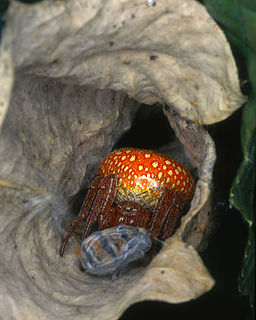
Araneus alsine, the strawberry spider or orange wheelweaving spider, is a species of the orb-weaving spider family, Araneidae.

Micrommata virescens, common name green huntsman spider, is a species of huntsman spiders belonging to the family Sparassidae.
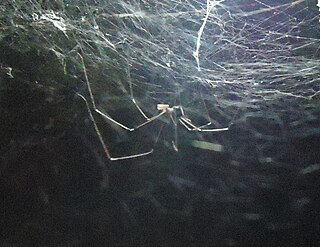
Crossopriza lyoni is a widespread species of cellar spiders that prefer to live in or around human structures. They are commonly known as tailed cellar spiders, tailed daddy longlegs spiders, and sometimes box spiders. They all possess extremely long fragile legs that can reach up to 6 cm (2.4 in) long and a body length of that ranges from 2.5 to 7 mm. Their abdomens are distinctly squarish when viewed from the side and their carapace is more or less circular when viewed from above. They also possess two kinds of sound-producing organs and have six eyes.

Ozyptila trux, the yellow leaflitter crab spider, is a crab spider species with Palearctic distribution.

Trochosa terricola is known as the ground wolf spider, is a wolf spider which is common and widespread in western and central Europe. It has been recorded as prey for the pompilid wasp.

Trochosa spinipalpis is a specialised species of Palearctic, wolf spider which is restricted to bogs and other wetlands.
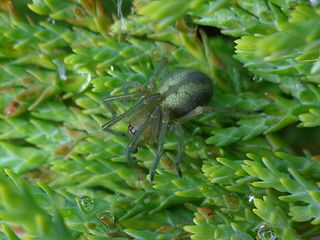
Cheiracanthium erraticum, the two-clawed hunting spider, is a species of Palearctic spider of the family Cheiracanthiidae.

Xysticus cristatus, the common crab spider, is a European spider from the family Thomisidae.
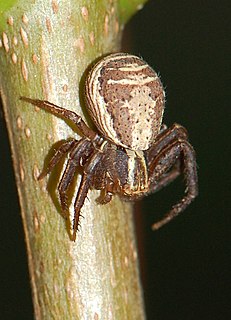
Xysticus ulmi, the swamp crab spider, is a European crab spider of the family Thomisidae which prefers damp habitats. It was first described by the German zoologist Carl Wilhelm Hahn in 1831.
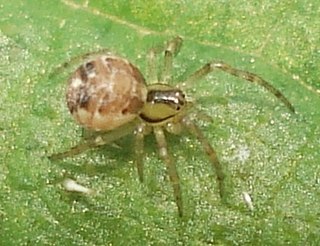
Phylloneta impressa is a species of comb-footed spider from the genus Phylloneta with a Holarctic distribution.

Cryphoeca silvicola is a small species of dwarf sheet spider in the family Cybaeidae which has a Palearctic distribution. The generic name, Cryphoeca, means hidden and the specific name silvicola means "living in the woods".

Heliophanus cupreus, the copper sun jumper, is a species of jumping spider belonging to the family Salticidae.

Zora spinimana is a prowling spider of the family Miturgidae with a Palearctic distribution. It is the type species of the genus Zora.
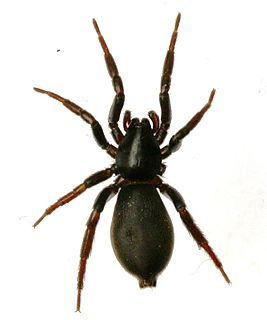
Zelotes subterraneus is a species of ground spider from the family Gnaphosidae which has a Palearctic distribution. it is the type species of the genus Zelotes. Its distribution may be somewhat masked by the difficulty of distinguishing this species from Zelotes apricorum and Zelotes latreillei.

Antistea is a genus of dwarf sheet spiders that was first described by Eugène Simon in 1898. As of May 2019 it contains only two species: A. brunnea and A. elegans. Combined, they have a Holarctic distribution, one Palearctic and the other Nearctic.
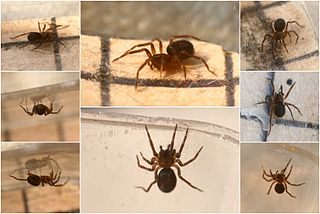
Iberina montana, the common combtailed spider, which was formerly better known as Hahnia montana, is a species of dwarf sheet spider, family Hahniidae, which is found mainly in Europe.

Scotina is a genus of sac spiders of the family Liocranidae which was named by the German zoologist Franz Anton Menge in 1873 with Scotina gracilipes as the type species. Scotina was thought to be a mainly Western Palearctic genus but one species, Scotina palliardi was found in Korea in 2011. The species in the genus Scotina are small spiders which have six to ten pairs of ventral spines which can be seen using a lens. They have a darker and shinier cephalothorax than in other genera within the Liocranidae. They also have light brown femora with the more distal segments of the legs are darker, especially on the first pairs. They are terrestrial spiders which are mainly found among moss and litter on the ground.
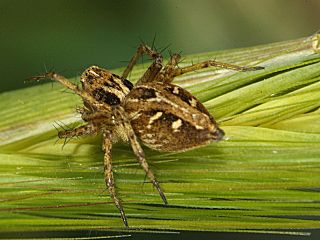
Oxyopes heterophthalmus is a lynx spider from the family Oxyopidae, it is the type species of the genus Oxyopes and was described by Pierre André Latreille in 1804, it has a Palearctic distribution.
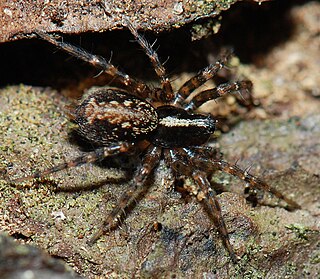
Textrix dendiculata, the toothed weaver, is a funnel web spider of the family Agelenidae found in much of Europe. It was described by the French entomologist Guillaume-Antoine Olivier in 1789. An older name coined by Martini & Goeze in 1778, Aranea cruciger, has been declared a nomen oblitum, allowing Olivier's later name to stand.

Tetragnatha montana, commonly known as the silver stretch spider, is a species of long-jawed orb weaver from the family Tetragnathidae that has a Palearctic distribution. It preys mostly on flies and mosquitoes. The name silver stretch spider refers to its shiny metallic colour and its habit of extending its legs into a stick like shape.




















